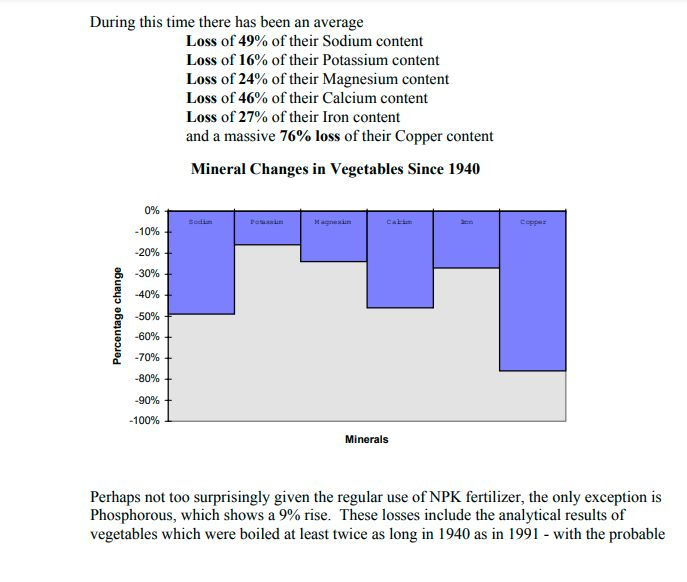
Image source: www.grazetech.com.au/site_files/3478/upload_files/DThomasUK_MineralDepletion_0.pdf .
A full score years ago – as Abe Lincoln may dramatical say for ’20 years ago’ – Thomas (2003) showed UK foods critically depleted in nutrients. Similar studies are available from USA or Australia, etc,. proving this a global phenomenon in agrichemical foodstuffs for folks, pets and our livestock; plus for some wildlife…
Thomas D. A study on the mineral depletion of the foods available to us as a nation over the period 1940 to 1991. Nutr Health. 2003;17(2):85-115. doi: 10.1177/026010600301700201. Online here – https://www.grazetech.com.au/site_files/3478/upload_files/DThomasUK_MineralDepletion_0.pdf .
The scandal is not so much that all our soils and foods are poisoned and devoid of goodness; rather, the scandal is that science shills fail to conduct proper, honest, studies comparing chemical to 100% real, organic produce. This failure allows Media to report all foods as equally bad and the laity swallows this, often parroting the lies. In truth, organic soils and produce are not as poisoned nor so depleted in nutrients.
This was shown in almost completely ignored or overlooked studies by Barański et al. (2014) and by Mayer et al., (2021/2022) that contradict the results of systematic reviews/meta-analyses by Dangour et al. (2009) and by Smith-Spangler et al.(2009 – herein called the Stanford report – which allegedly claimed that there are no significant composition differences between organic and conventional crops. As Dr Evil would say – ‘Riiiight‘. Just the raised cadmium (Cd) levels and pesticide residues in “conventional” food should be a major worry… Here are the plausible and credible citations:
Barański M, Srednicka-Tober D, Volakakis N, Seal C, Sanderson R, Stewart GB, Benbrook C, Biavati B, Markellou E, Giotis C, Gromadzka-Ostrowska J, Rembiałkowska E, Skwarło-Sońta K, Tahvonen R, Janovská D, Niggli U, Nicot P, Leifert C. (2014). Higher antioxidant and lower cadmium concentrations and lower incidence of pesticide residues in organically grown crops: a systematic literature review and meta-analyses. Br J Nutr. 112(5):794-811. doi: 10.1017/S0007114514001366.
Anne-Marie Mayer, Liz Trenchard & Francis Rayns (2021/2022) Historical changes in the mineral content of fruit and vegetables in the UK from 1940 to 2019: a concern for human nutrition and agriculture, International Journal of Food Sciences and Nutrition, 73:3, 315-326, DOI: 10.1080/09637486.2021.1981831. They also cite several other organic food comparison studies.
A limited study by Fan et al. (2008) was on wheat grain depletions at Rothamsted from the 1840s. Important to realize too, is that claims of nutrients decline since 1840s or 1940s are ridiculous false-reasoning if rapid rates of decline have been mostly in the last few decades, as with species loss (Ref.). An 80% decline claimed over 180 years is just 0.25%/yr, a true decline of 80% in 40 years is about 2%/yr. Moreover, declines of nutrients – as for insects or earthworms – if studied in just the last few years, may be in already collapsed states, that is, from values or populations already reduced from their 100% optima.
It seems an almost global phenomenon – at least in heavily agrichemical countries (and where isn’t?) – that our foods are not only being poisoned with toxins but also increasingly depleted in nutrients and mineral over the last few decades. Exception is water content that may have small increase (hence claims of higher yields?). The number of studies confirming agrichemical food depletion are not, as yet, routinely compared to wholly 100% organic foods. However, the further back the comparison, the more likely the foods are to have been mostly organic, and today several organic farms or trials have maintained their principals and saved their heirloom seeds so that they may reasonably represent soil and plant conditions pertaining in pre-agrichemical-frenzy time. But not necessarily at places such as Rothamsted Research that claims to use organic fertilizer in the form of Farm-Yard-Manure (FYM – a coarse form of compost that is now from dubious cattle stock that are often heavily inoculated, drenched, and fed the same depleted foodstocks) over the last 180 years. Here, their “organic” FYM plots also been treated with toxic agrichemicals, as noted below. Moreover, each year they use new seeds for each crop, failing to save their own, as most good farmers would surely do. Admitting nutrient depletion (see Fan et al. 2008), their claim that this is due to new plant varieties is counter-indicated by declines corresponding more with timings of synthetic-fertilizer, herbicide and fungicide introduction as so blatant a failure to admit such factors thereby posing a major flaw in their analysis and in their deliberately weak interpretation of facts:-
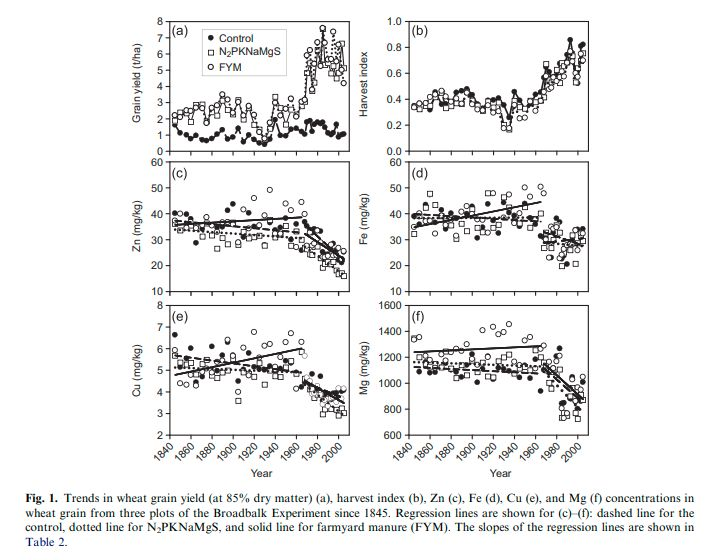
Fan et al. (2008: fig 1c-f) has dramatic wheat minerals decline from the mid-1960s, not the 1840s nor 1940s. As the figure below, modified from https://web.archive.org/web/20201113062957/https://www.rothamsted.ac.uk/sites/default/files/RRes_LTE%20Guidebook_2018_%20web%20AW.pdf fig. 1, shows the “Modern cultivars” of shorter-strawed cultivar Cappelle Desprez were introduced into Broadbalk harvests in 1968, around the time of mineral declines. But this report also states “Another major change, introduced in 1968, except on Park Grass, was the replacement of ammonium sulphate and sodium nitrate by ammonium nitrate, initially as ‘Nitro-Chalk’ (calcium ammonium nitrate), now as ‘Nitram’ (ammonium nitrate).” This is not noted by Fan et al. (2008), rather they claim: “In 1968, the experiment was divided transversely into 10 sections, each of which have received different agronomic treatments (continuous wheat, crop rotation, straw incorporation, no herbicide, no fungicide), but the same fertilizer treatment“. Why lie about fertilizers?
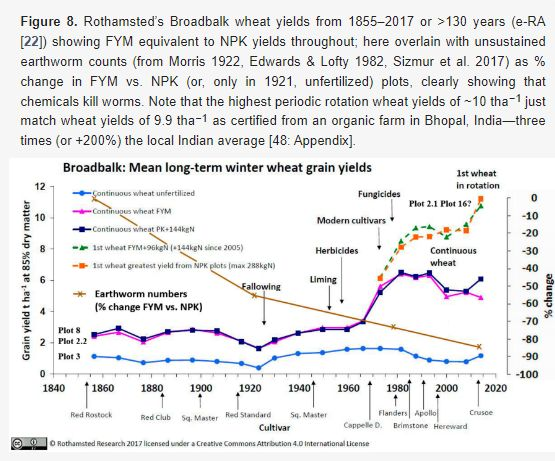
Broadbalk plots of concern from Blakemore (2018: fig. 8 that is charted from 1855 rather than the actual starting date of 1839; the brown line I added corresponds to decline of earthworms there – from Rohamsted’s own data!). The doubling of yields, starting from 1968 relate as much – or more so – to the re-introduction of crop rotations (e.g. Rothamsted report: pages 8-10) that have been an aspect of agriculture from pre-Saxon times. Please see the footnote on Oat and Corn yields in FYM plots also much higher than NPK plots!! Also note timing of 1960-1980s “Herbicides” and “Fungicides” compared to inadequate (and somewhat confused) attribution of grain mineral declines to 1970s “Modern cultivars” alone! Patently something is seriously wrong with their interpretations. Interestingly, their earlier 2008 conference paper included Rothamsted chemist Jackalin Stroud as co-author who, although unqualified and with no cause, attacked my 2018 ecological paper on earthworm declines in agrichemcial fields including earlier Rothamsted studies (from Morris 1922, Edwards & Lofty 1982, Sizmur et al. 2017, etc.). What I don’t understand is how she would claim she has not worked with Tom Sizemur when they got >$1 m (AHDB Project Report No.576 actually £1,084,999) fund and jointly published together, plus his May, 2017 study quoted her study looking at earthworms at the same time in the same field… Yeah, happens to me all the time that I forget people and those pesky $1 m projects… Such are the cheap & dirty games chemists play, only for $$s profit pay…
Here is our brief email exchange extract:
| ” Robert Blakemore <rob.blakemore(ato)gmail.com> | Wed, 8 Nov 2017, 02:12 |   | |
to jacqueline.stroud | |||
Hello Jackie,
Researching my projects in Asia I came across your work at Rothamsted. Actually I just wrote to Tom Sizmur about their survey as there were several mistakes in their paper Appl Soil Ecol. 2017 May; 113: 166–177. doi: 10.1016/j.apsoil.2016.12.006. Couldn’t work out whether they actually surveyed the FYM and zero plot, or some combination of the N plots. I sent him a link to my earlier earthworm work at Haughley. You too may be interested… http://orgprints.org/30000/ .
Cheers, Rob Blakemore“
| ” Jacqueline Stroud <jacqueline.stroud@rothamsted.ac.uk> | Thu, 9 Nov 2017, 04:23 |   | |
to me | |||
Dear Rob
I remember you got that article into Nature about the importance of earthworms, great stuff!
I’ve not worked with Tom. As you mention worms in Broadbalk…. this Autumn I mapped earthworm populations on all continuous wheat sections (and other soil health indicators) and I’m going to present results at the IFS conference in December…” What? Not worked with Tom… Really?? How about:
“(AHDB Project Report No.576) D1 – Technical reports: non-confidential by Whitmore, A. P., Watts, C. W., Stroud, J.L., Sizmur, T., et al. 2017.” Why lie about it?
In 2019 Tom Sizmur did at least publish a correction to his flawed paper (though he forgot to acknowledge my contribution in pointing out these errors!): https://doi.org/10.1016/j.apsoil.2018.10.013.
It gets much, much darker when these paid chemists allege toxic glyphosate is actually beneficial to Earthworm Ecology – onlinelibrary.wiley.com/doi/full/10.1111/aab.12838! Rather than detrimental effects on ALL soil biota, plants and animals (including humans), as are reported below, she claims: “it seems that the use of glyphosate stimulates the colonisation of plant residues by a litter-fungus complex that increases foraging and feeding activities by anecic earthworms.” In their twisted world they imply ubiquity of glyphosate contamination is actually good for fungi and for earthworms. Just for $$s…
“The post-registration monitoring of glyphosate-treated plants using anecic earthworms by J.L. Stroud, Kirstie Halsey. 28 April 2023. https://doi.org/10.1111/aab.12838.” This Rothamsted paper also claims: “CONFLICT OF INTEREST STATEMENT The authors have no conflicts of interest to declare.”
Yet a recent 2022 report of adverse effects (Ref.) notes: “Glyphosate also seems to exert a significant toxic effect on neurotransmission and to induce oxidative stress, neuroinflammation and mitochondrial dysfunction .. Although there are important discrepancies between the analyzed findings, it is unequivocal that exposure to glyphosate produces important alterations in the structure and function of the nervous system of humans, rodents, fish, and invertebrates.” Worms are of course included in invertebrates.
Actually, we also do not need to look any further than glyphosate to find the cause of mineral depletion (and microbial extinctions) as this is reported here – https://beyondpesticides.org/dailynewsblog/2021/10/glyphosate-kills-microorganisms-beneficial-to-plants-animals-and-humans/ .
Chemical companies & their paid shills intimidate or threaten any dissent, like all bullies do. UK’s Rothamsted Research, a renowned agricultural center with some of the longest running field trials advertizing agrichemicals, operates as “a company limited by guarantee” in collaboration with the mega-corporate likes of Bayer & Syngenta (e.g. https://web.archive.org/web/20181022092148/https://www.fginsight.com/news/news/rothamsted-and-bayer-form-alliance-on-sustainable-crop-care–23666 ; https://web.archive.org/web/20190103055955/https://www.cambridgenetwork.co.uk/news/rothamsted-syngenta-multi-million-partnership/). Their annual report 2015/2016 lists: “Dr Jacqueline Stroud
As a soil chemist on her first foray into biology Jacqueline explains why earthworms are so fascinating” who, seemingly as their representative, has attacked my 40 years experience in earthworm research while claiming to care for “soil health” as an instant “earthworm expert“. Under “Partners and Funders:” the 2015 Annual Report also lists Syngenta a top chemical company. My advice: “Farmers: Beware!” Do not let such dumb chemists onto your land, especially those who – by their own admission – are unqualified to “foray” into earthworms nor for that matter any agricultural aspect of this broad field of Soil Ecology …

Sponsored by Bayer!! Truly the best way “to improve soil health” is to not listen to them.

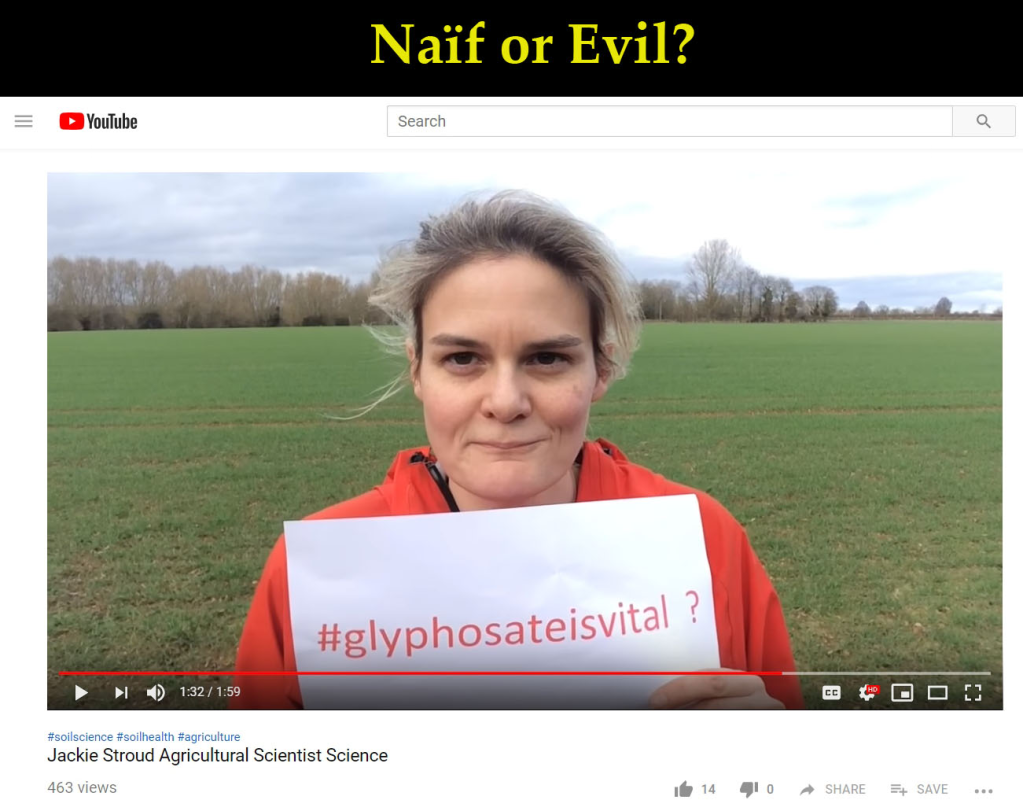
Bitchin’ for Bayer or $hillin’ for $yngenta? Actually most paid-off academics are more like Spruikers than Shills… See Warning to Farmers – https://vermecology.files.wordpress.com/2020/10/farmers2.pdf.
Back to the mineral decline report… Other major inconsistencies & omissions of Rothamsted’s Fan et al. (2008: tab. 1) report are lack of clarity on where the FYM grain samples truly came from and – crucially – they omitted to consider N2 synthetic fertilizer addition to plot “21” from 1968 as a factor! Furthermore, there are no plots “22” and “21” on Broadbalk; perhaps they mean 2.1 and 2.2?! As isn’t it a bit childish if they only do this to put FYM at the bottom of their Table 1 list? Why lie about it?
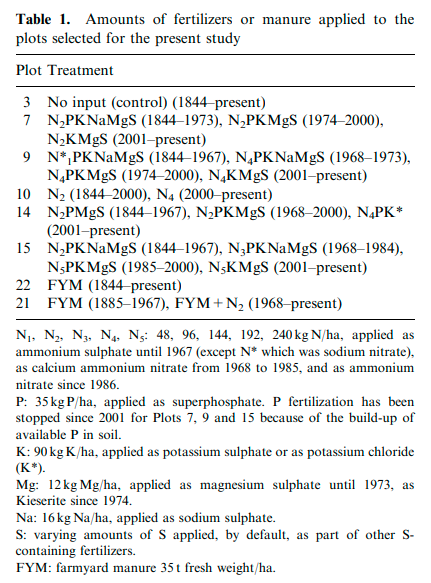
Compare this to Rothamsted’s official Broadbalk plot design (below) showing 2.1 received N2 from 1968 corresponding to FYM plot decline further stating: “After the 1968 changes.. Pesticides are applied where necessary.. Herbicides have been used as required since 1964 on all of the experiment” – in both 2 FYM plots & “Control” 3 too?! So there is zero comparison in Rothamsted plots with anything that could be construed as 100% organic… – https://www.era.rothamsted.ac.uk/Broadbalk#design/.
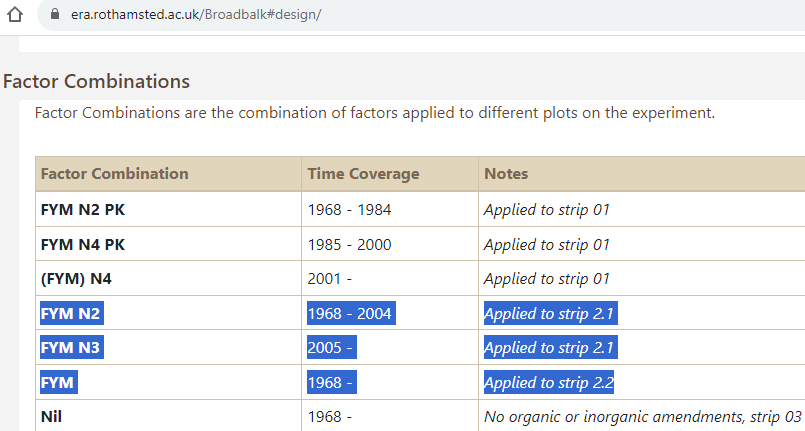
An innocent question: When Broadbalk was set up, is the true control likely to be plot 3, or plots 1 & 2 with FYM? It may be contended that the true control against the agrichemical plots are FYM plots 1 & 2…
Aside from McCance & Widdowson (1940), around the globe early nutrient analysis studies were completed as long ago as the early 1990s and 2000s (e.g. Mayer 1997 and Thomas 2001, 2003, 2007 in UK, or Smith 1992 and Davies et al. 2004 in USA – these publications not widely cited for some reason…). Latest reports in more popular media are by National Geographic (May, 2022 – https://www.nationalgeographic.co.uk/environment-and-conservation/2022/05/fruits-and-vegetables-are-less-nutritious-than-they-used-to-be) and Children’s Health Defense (August, 2023 – https://childrenshealthdefense.org/defender/nutritional-value-food-public-health-cola/) or podcast by UKColumn (August, 2923) – https://www.ukcolumn.org/video/health-matters-a-relaxed-chat-with-clive-de-carle. Both the articles mostly recommend more organic practices to solve this major, insidious, and totally un-necessary problem. As well as advocating organic, the latter publication also recognizes that “there is a range of practices that could be referred to as regenerative, even though they’re only slightly different from conventional, chemical farming” as was also reported by Beste (2019 – https://www.arc2020.eu/comparing-organic-agroecological-and-regenerative-farming-part-3-regenerative/) who said “Similar to agroecology, the term “regenerative agriculture” is not yet protected officially, nor is there a clear definition on international or national level. Thus, conventional farms can also claim to operate “regeneratively” and that “The term “regenerative agriculture” is introduced as a basic term. There are good reasons for this. The concept of organic agriculture does not fit at all into the business concept of most of the companies gathered here. Just take Yara, the world’s largest producer and trader of mineral fertilizers. Organic agriculture is THE total threat to its business concept.” Furthermore Beste (2021 – https://www.martin-haeusling.eu/images/GREENWASHING_AND_HIGH_TECH_-_Faking_it_un-sustainable_solutions_for_agriculture_WEB.pdf) quotes: “The pesticide industry in particular invests heavily into advertising “climate protection strategies” and “regenerative agriculture” or “carbon farming”” citing a study by Kelly & Rankin (2020 – https://www.desmog.com/2020/11/18/pesticides-industry-climate-change-marketing-pr/) that said: “the pesticides industry is putting huge resources in marketing climate action strategies attached to two labels: precision agriculture, and regenerative agriculture — with both items falling under the even broader umbrella terms “climate smart” or “climate resilient” agriculture“. Beste (2021) also cautioned: “It is therefore very important to look closely at what is behind a project with the label “regenerative agriculture” or “agroecological”. It can be a very good one or simply greenwashing!“.
Moreover, a seemingly reasonable summary is provided in a 2019 Civil Eats Report that says “One of the reasons herbicide is rarely discussed in the context of regenerative agriculture is because regenerative practices have been largely adopted by conventional, chemical–dependent operations. According to the latest Census of Agriculture, cover cropping and reduced tillage have experienced a boom in recent years. By 2017, no-till and reduced till accounted for about two-thirds of America’s cropland” and, tellingly: “And yet, today, the vast majority of conventional farmers who use regenerative methods continue to use pesticides, according to a survey by No-Till Farmer, a leading magazine for the regen crowd. Some 92 percent of respondents planned to use glyphosate for weed control, and the majority said they would plant crops that had been engineered to withstand its use“. So it is not just me exposing the sham of RI…
A summary of the mineral & nutrient depletion issue, with solutions such as “1. Switch to organic fruit and veg“, is provided here:- https://www.hollandandbarrett.com/the-health-hub/food-drink/nutrition/dirt-poor-declining-nutrient-levels-soil/ . Compared to the limited study by Fan et al. (2008) on wheat grain, a most recent review for Fruits & Vegetables is by Mayer et al., (2021):
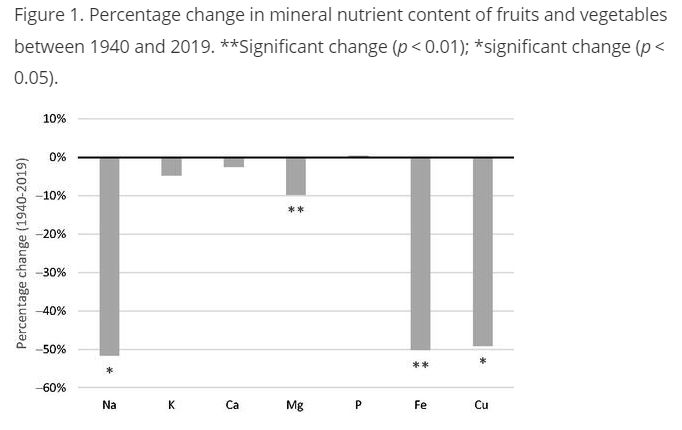
Figure from Mayer et al., (2021)for mineral declines in UK Fruit & Veggies.
The issue is more widespread than just the UK or USA studies reported above as surely it occurs in other regions too (see figure below from flawed 2020 study – https://doi.org/10.1038/s41598-020-78504-x that makes exactly zero mention of “organic” thus is not a true, honest, comparison of crops). Such arguments of mineral deficiencies from changes in cultivated varieties or climate are clearly deliberate distractions from main soil mineral/soil biota depletions, especially as organic farmers are heirloom/heritage “seed savers” too and are subjected to the same climates as well.
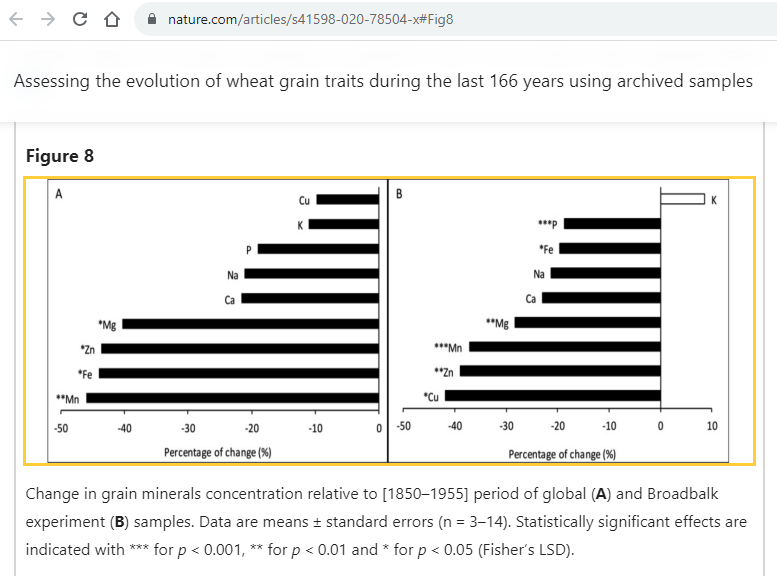
Criticism of studies like those of the McCance & Widdowson reports by Thomas (2003, 2007) by Marles (2017 – https://www.sciencedirect.com/science/article/pii/S0889157516302113#sec0040) were not only unoriginal, incomplete and poorly formulated, they had, for the most part, already been addressed in an earlier rebuttal section (“DISCUSSION 1. Issues from the previous paper”) by Thomas (2007 – https://downloads.clinicaleducation.org/protected-seminars/plm-jan19/research-papers/5/20-slide-the-mineral-depletion-of-foods-available-to-us-as-a-nation-(1940-2002)a-review-of-the-6th-edition-of-mccance-and-widdowson..pdf))! People funded by the agrichemical industry often attack such studies.
Furthermore, a supposedly independent but highly suspect report by Stanford University in 2012 decided that “there isn’t much difference between organic and conventional foods” – https://www.acpjournals.org/doi/10.7326/0003-4819-157-5-201209040-00007?articleid=1355685 here with a nifty propaganda video by some of the smug authors. They emphatically declared “Primary Funding Source: None.” Yet seemingly this is not entirely true as the institute supporting the study receives $millions from the agrichemical farming industry according to this highly critical review – https://www.cornucopia.org/2012/09/stanfords-spin-on-organics-allegedly-tainted-by-biotechnology-funding/ saying “that the agribusiness giant Cargill, the world’s largest agricultural business enterprise, and foundations like the Bill and Melinda Gates Foundation, which have deep ties to agricultural chemical and biotechnology corporations like Monsanto, have donated millions to Stanford’s Freeman Spogli Institute, where some of the scientists who published this study are affiliates and fellows.”
The Stanford study failed on several other important health factors too according to another published review – https://ehp.niehs.nih.gov/doi/10.1289/ehp.120-a458. Mainstream media (MSM) reports were somewhat ambivalent and twisted, e.g. NYT or LAT the latter with one notable quoted as saying: “I think the conclusions are pretty good from the organic point of view,” he said. “I don’t understand why people get so worked up about it.” I can tell you why people should get so worked up… Chemical companies spend $billions to obfuscate any negative reports and spread the notion that organic farms compete equally with conventional. In fact organic farms only make up less than 0.75% of all global farmland, as is noted below. The present global extinction & health crisis is due almost entirely to agrichemicals, their misuse and overuse. Organic farming has few penalties & many all-round benefits that are not being widely shared. We could do so much better but don’t. That’s why sensible people get “so worked up” mister.
Unsurprisingly, Bayer-Monsanto, loves the Stanford report – https://www.bayer.com/en/ca/canada-organic-or-conventionally-grown … and, as well as pretending to care about worms, has also kidnapped, greenwashed and twisted Regen:

Syngenta too, as well as pretending to care for worms, loves “Regenerative Agriculture” – https://www.syngentagroup.com/en/regenerative-agriculture. Need I say more?

OK more, Wiki: “Syngenta was founded in 2000 by the merger of the agrichemical businesses of Novartis and AstraZeneca, and acquired by China National Chemical Corporation (ChemChina) in 2017.[2].” AstraZeneca and Novartis are both in the top ten of Pharmaceutical Companies while, ChemChina is a Chinese state-owned enterprise, i.e. CCP. Who says government, Agrichem & Big Pharma are not in bed together?
Other corporations are culpable too, e.g. IG Farben that made use of slave labor and produced Zyklon-B, after the war became BASF, Hoechst AG, the Agfa-Gevaert Group, and Bayer Pharmaceutical. Maker of Napalm-B, Agent Orange and the Bhopal tradgedy, Dow Chemical is questioned over its toxic 2,4-D – https://www.nrdc.org/stories/24-d-most-dangerous-pesticide-youve-never-heard . It has now split to try to limit its liabilities:- Less than two years after its formation, DowDuPont — the chemical giant formed by the merger of Dow Chemical and E.I. du Pont de Nemours — was replaced by new spinoffs Dow (DOW), DuPont de Nemours (DD), and Corteva. The many victims of 1984 Bhopal distaser have never been fully compensated, now near its 40th anniversary, nor has the site’s environment yet been cleaned up (pers. obs.)..
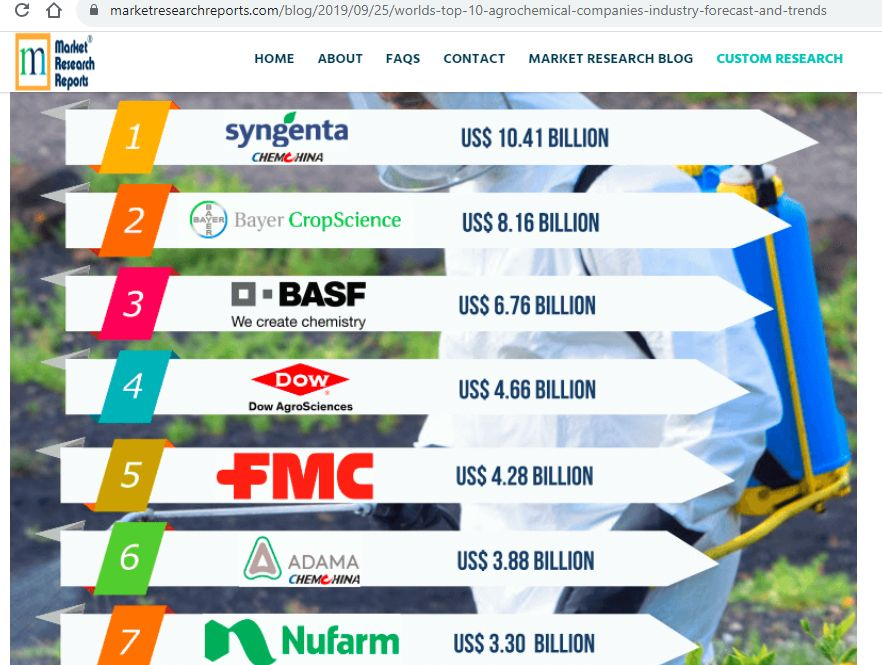

Not sure how they did it but Bayer, which includes both big AG and big Pharma, seems to gross a total between $50-$100 billion per year in 2022 putting them up there with the other big players listed above.
It is not in the interest of either Big Ag nor Big Pharma to compare their products with nor to support 100% organic farming or herbal remedies, for obvious & highly cynical reasons (not that difficult to surmise: it is just $$s). But they openly support “Regenerative Agriculture“. Why do you suppose that is?
All of the few remaining earthworm or organic researchers that I know of are funded directly, or indirectly via their institutions (not one SOIL ECOLOGY INSTITUTE remember…), by one or more of the Agrichem companies listed above and/or by their Pharma conglomerate cousins. Not one earthworm or “organic” researcher dare to criticize Glyphosate or Atrazine, etc., etc.. I, on the other hand, report the truth in Science (e.g. from Blakemore 2023 that was totally self-funded, i.e., no one paid this piper for the tune):-
“3.13.4. Toxic Agrichemical Biocides
Amongst many as yet not fully blanket-banned agrichemicals are formulation of Atrazine by ChemChina/Syngenta or Glyphosate by Bayer/Monsanto used as herbicides or crop drying agents. Glyphosate is especially counterproductive since it is patented as an anti-microbial (Patent No. US7771736B2). Not limited to Enterobacteriaceae essential to our digestive health, it is also toxic to (N-fixing) soil bacteria (Santos & Flores 1995, Van Bruggen et al. 2018), fungi (Vazquet et al. 2020), algae, and other organisms (Singh et al. 2020). Glyphosate was known to affect essential eukaryotic mitochondria function since 1970s (Olorunsogo et. al. 1979, Peixoto 2005, Myers et al. 2016, van Bruggen et al. 2021, Strilbyska et al. 2022, Mesnage et al. 2022). How much this destruction of soil biota adds to soil CO2 or NOx emissions is unclear as this subject seems as yet uninvestigated. Such chemicals pollute our soil, air, water, food, and bodies being linked to infertility and severe human or animal illnesses, including cancer. Formulations are toxic to soil fungi in ultra-low doses (Nicolas et al. 2016) and play a non-trivial role in emergence of antibiotic resistant bacteria (Raoult et al. 2021, Liao et al. 2021), although this is a common characteristic amongst competing soil microbes, especially fungi (Bahram et al. 2018). Deleterious effects of glyphosate on earthworms are well reported (Gaupp-Berghausen et al. 2015) which alone indicates a need for caution. Wider ecological problems of agrichemical farming, as opposed to organic husbandry that includes earthworms as essential farm stock, are summarized by Blakemore (2018a) and by Martinez et al. (2021). Transitioning to agriculture methods free of synthetic fertilizer or pesticides, i.e., 100% organic, is seen as an important objective in Europe (Jacquet et al. 2022). At the same time, terms such as “regenerative” or “agroecology” are often being misappropriated by chemical industry and research interests with promotion of unproven or harmful methods such as chemical no-till (using glyphostate) or excessive marketing of unproven charcoal “char” rather than regular and much more natural compost/mulch (Beste 2022).” Just to reiterate, often herbicides, fungicides, etc. are truly just biocides…
The recent summary of the key nutrient issues (not that I agree with all of their statements) is by National Geographic (2022 – https://www.nationalgeographic.co.uk/environment-and-conservation/2022/05/fruits-and-vegetables-are-less-nutritious-than-they-used-to-be ) that cites studies from USA and from Australia with similar issues as were found in the UK studies. Viz.: https://pubmed.ncbi.nlm.nih.gov/15637215/ ; https://www.ncbi.nlm.nih.gov/pmc/articles/PMC8750575/ – this latter study by Erbl et al. (2021) was titled: “Temporal Change in Iron Content of Vegetables and Legumes in Australia: A Scoping Review”
Australia also has wider health and environmental issues as Dr Christine Jones interview found:
CJ: “It’s nonsense to say biocides don’t damage soil! In Australia many farmers plant seeds treated with fungicide “just in case.” They’re actually preventing the plant from forming the beneficial associations that it needs in order to protect itself. After a few weeks of crop growth, they will then apply a “preventative” fungicide, which also finds its way to the soil, inhibiting the soil fungi that are essential to crop nutrition and soil building. The irony is that plants are then unable to obtain the trace elements they need to fight fungal diseases. We see many examples of crops grown biologically that are rust-free, side-by-side with rust infected plants in neighboring fields where fungicides are being used. There is an analogous situation with human health. Not that long ago the cancer rate was around one in 100. Now we’re pretty close to one in two people being diagnosed with cancer. At the current rate of increase, it won’t be long before nearly every person will contract cancer during their lifetimes. Cancer is also the number one killer in dogs. Isn’t that telling us something about toxins in the food chain? We’re not only killing everything in the soil, we’re also killing ourselves — and our companion animals. Is that what we want for our future?
Q: You say it’s not just the toxins in our food that are the problem, but the use of biocides — chemicals that kill living organisms — which reduce the nutrient content of food. And you attribute that nutrient reduction to the inhibition of the plant-microbial bridge.
CJ: Spot on. If the plant-microbe bridge has been blown, it’s not possible for us to obtain the trace elements our bodies need in order to prevent cancer — and a range of other metabolic disorders. Cancer is not a transmissible disease. It’s simply the inability of our bodies to prevent abnormal cells from replicating. To date, the response to the cancer crisis has revolved around constructing more oncology units, employing more oncologists and undertaking more research. The big breakthrough in cancer prevention will be in changing the way we produce our food.
We have plenty of evidence from meta-studies that the nutrient content of produce grown organically tends to be higher than produce grown chemically. We also have documentation of steep declines in nutrient content in a number of foods over the last century.”
[All above quoted from Dr Christine Jones in Acres USA magazine published: Mar 1, 2015 and updated: Mar 22, 2021 – https://regenfarming.news/articles/917-sos-save-our-soils-dr-christine-jones] .
An early global meta-analysis by Brandt et al. (2011) found “published comparisons of the content of secondary metabolites and vitamins in organically and conventionally produced fruits and vegetables showed that in organic produce the content of secondary metabolites is 12% higher than in corresponding conventional samples ( P< 0.0001).” [Note their increase in life expectancy addendum is a bit trite as the bigger issue is of cancer and neurolgical damage, plus extinctions and wider health issues too]. An Australian study by Hunter et al. (2011) found organic foods with higher micronutrients than conventional crops with “a mean percent difference in micronutrient content favoring organic vegetables (+5.9%, P<0.001) and legumes (+5.7%, P<0.001“; and a 2016 study reported benefits of organic milk in UK – https://pubmed.ncbi.nlm.nih.gov/26878105/ concluding that “organic bovine milk has a more desirable fatty acid composition than conventional milk. Meta-analyses also showed that organic milk has significantly higher α-tocopherol and Fe, but lower I and Se concentrations.” What I would now recommend is for real 100% organic farmers and growers (e.g. USA’s https://www.realorganicproject.org/) to request similar independent Scientific comparison of contemporary organic produce with the same chemical (or fake hydroponic!) offerings. It may be reasonably predicted that organic food will be most nutritious and safe. After all, it is what sustained humanity up to the last few decades of almost deliberate toxic decline. Taste alone may be a decider as organic food, the fresher the better, has much more flavour and texture.
Mothers in particular may be especially interested in such findings as smaller children seem most susceptible and may bear the toxic burden for a longer time while also spending fortunes on supplements and medicines to treat their kids’ continued ill-health. With momma bears onside, the restoration (not regeneration!) of safe & healthy, and inevitable, 100% organic farming may progress much more rapidly.
Urgency is manifest in the almost universal contamination of our air, water, soils and foods so that neither pristine soils nor organic farmlands remain uncontaminated. E.g. agrichemical residues found in both organic soils and their earthworms (Pelosi et al. 2021), including glyphosate (Pelosi et al. 2022). Mesnage et al. (2015) had reported rat chow from organic sources were often contaminated with agrichemical products including glyphosate, GMOs, heavy metals, etc., with likely underestimation of toxicity assays.
Such assays are by Clair et al. (2012) over 10-years ago showing glyphosate to be an endocrine disruptor: “At lower non toxic concentrations of Roundup and glyphosate (1ppm), the main endocrine disruption is a testosterone decrease by 35%.” Also in female rats, e.g. Ingaramo et al. (2020) had “endocrine-disrupting effects of exposure to glyphosate and GBHs at low or “environmentally relevant” doses in the female reproductive tissues” and, most recently, Chitolina et al. (2023) found: “Roundup® causes endocrine disruption of hormones related to female fertility and reproduction and changes the oxidative status“.
It’s not just me saying this. The International Federation of Gynecology and Obstetrics (FIGO),Reproductive and Environmental Health Committee: “We recommend that glyphosate exposure to populations should end with a full global phase out.” (2019). As do many others (e.g. Ref.)
So the battle is just beginning. Despite the counter-propaganda by Agrichem/Regen crowd suggesting serious competition, globally only about 75 million hectares – or 1.5% – of farmland is organic (https://www.fibl.org/en/info-centre/news/global-organic-area-continues-to-grow-over-723-million-hectares-of-farmland-are-organic ; https://www.statista.com/statistics/268763/organic-farming-area-worldwide-since-2000/). However, half of this (ca. 35.7 million ha) is in Australia where marginal semi-desert rangelands of thousands or ten of thousand hectares per cattle or sheep station with low stocking rates have no option but to reduce chemicals. The total farm- or range-land in Australia is claimed by Australian DAFF as 427 million hectares but, as their figure below shows, most is in the arid, semi-desert that is most fragile and susceptible to erosion, fires and desertification (rather obviously, especially when huge areas are still being cleared of native forest for iffy pasture!).
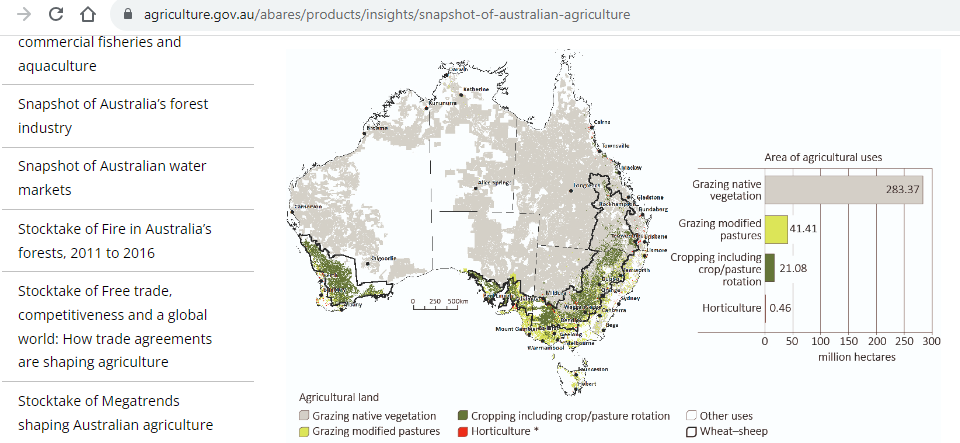
Anna Creek (photo below) at 23,677 km2 or 2.4 million ha (same as Sardinia) is the largest cattle station:
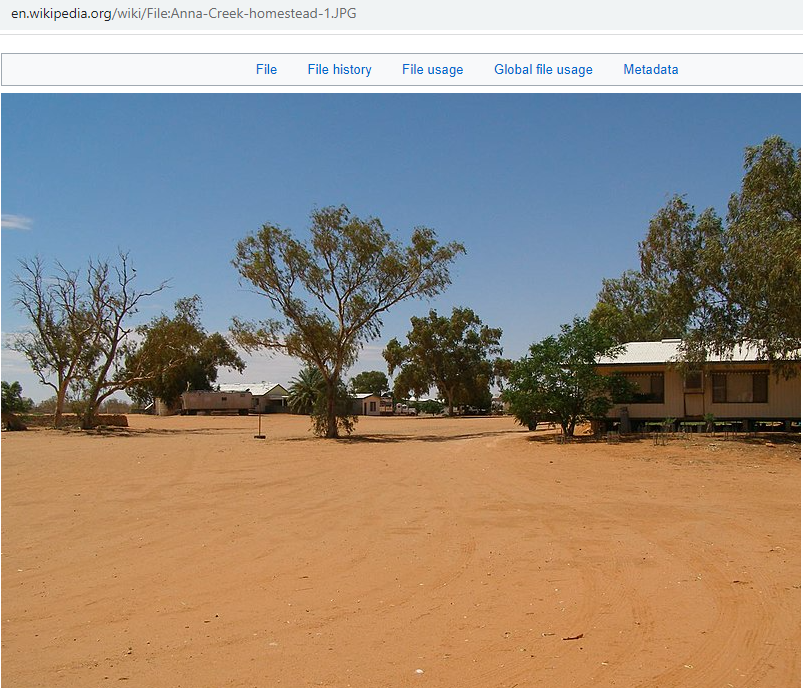
The second largest cattle station was advertized for sale with an organic herd of 18,000 head on 16,500 sq km or 1.65 million ha (https://thenewdaily.com.au/finance/property/2018/05/17/second-largest-cattle-station-on-earth/ photo below that I guess it taken from atop an wind-powered water pump). By my calculations this is 90 ha or 222 acres per cow. In greener pastures, average stocking rates are about 1 cow per acre per year. Yeah, no point wasting expensive agrichemicals there…
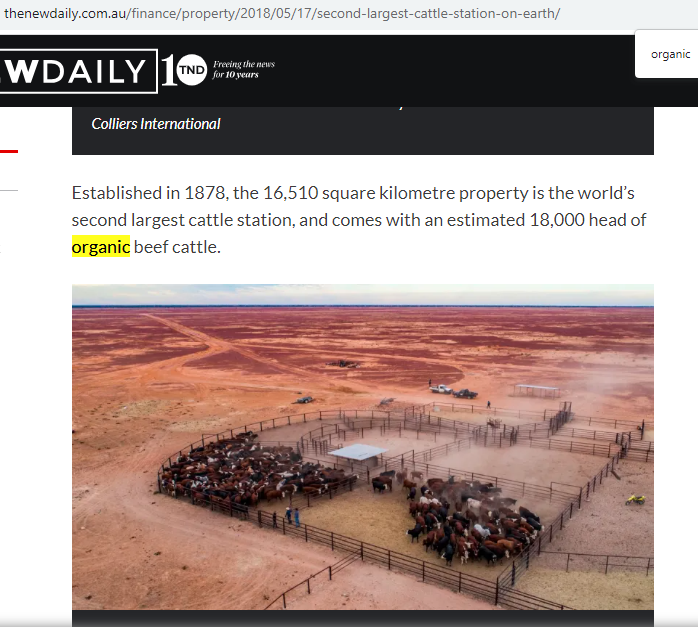
Cows need about 50 litres of water per day, 100 litres in dry country and they die in deserts as there is neither food nor water. Stupid Savory ideas of taking more cows into deserts is more than idiotic. This is not just me saying this, so too do many other thinking people, e.g. https://www.thewildlifenews.com/2013/03/18/alan-savory-gives-a-popular-and-very-misleading-ted-talk/, https://www.sierraclub.org/sierra/2017-2-march-april/feature/allan-savory-says-more-cows-land-will-reverse-climate-change, https://www.tabledebates.org/research-library/holistic-management-critical-review-allan-savorys-grazing-method, http://www.inexactchange.org/blog/2013/03/11/cows-against-climate-change/. So please do not say this arrogant and ignorant man is a hero. Overgrazing (especially by cattle, sheep or goats) expands deserts. Excess meat eating is the single most damaging human activity and anyone who bemoans environmental issues and eats meat is hypocritical; see:- https://vermecology.wordpress.com/2020/11/19/cow-km/; https://vermecology.wordpress.com/2022/03/30/critical-issues/; https://vermecology.wordpress.com/2022/02/18/csp/.
The next largest organic areas are in Argentina (3.7 million ha) and Spain (2.4 million ha – same as Anna!), both also partly semi-arid. Currently countries with the most organic share of their total farmland are Liechtenstein (41%), Austria (26%) and São Tomé & Príncipe (25%). Some states in India aspire to be 100 % organic in coming years. Sixteen countries, have 10% or more of their agricultural land organic, but the only country now wholly, 100% organic is Bhutan, as shown by the tiny green dot in the map below…

Sadly, while progress is made, true organic farm/gardens maybe halved, to just 0.75% of total farmland.
The hackneyed canard that organic foods cost more is easily debunked if agrichemical (and pharmaceutical, often from the same conglomerate) subsidies were removed and the soil, health and environmental destruction were factored in as tangible costs. Relatively, organic is then much less costly…
This was discussed in my 2021 video – https://www.facebook.com/inboundambassador/videos/how-soil-health-and-worms-are-essential-for-sustainability-ssl202/3698437047047997/ and podcast – https://www.listennotes.com/podcasts/seek-sustainable/more-research-is-needed-for-t7EnFCBc3oi/ .
The need is for proper cost-benefit analysis, honesty, and realization that unemployment, over-urbanization, chronic illness and hunger can be easily overcome if people return to organic/Permaculture.
R.J.B, Kangaroo Valley, August, 2023.
REFERENCES
Brandt, K. et al. (2011) Agroecosystem Management and Nutritional Quality of Plant Foods: The Case of Organic Fruits and Vegetables. Critical Reviews in Plant Sciences. 30:1-2, 177-197. DOI 10.1080/07352689.2011.554417; https://eprints.ncl.ac.uk/fulltext.aspx?url=168871%2f356D6523-5744-496A-80B7-0A7FB08D5E79.pdf&pub_id=168871&ts=638304231306350076.
Eberl E., Li AS, Zheng Z.Y.J., Cunningham J., Rangan A. (2021). Temporal Change in Iron Content of Vegetables and Legumes in Australia: A Scoping Review. Foods. 11(1):56. doi: 10.3390/foods11010056. PMID: 35010182; PMCID: PMC8750575.
Fan, M.S., Zhao, F.J., Fairweather-Tait S.J., et al. (2008). Evidence of decreasing mineral density in wheat grain over the last 160 years. J Trace Elem Med Biol. 22(4):315-24. doi: 10.1016/j.jtemb.2008.07.002.
Mayer A.-M. (1997). Historical changes in the mineral content of fruits and vegetables. Br. Food J. 99: 5. doi: 10.1108/00070709710181540.
Mayer, A.B., Trenchard, L., Rayns, F. (2021). Historical changes in the mineral content of fruit and vegetables in the UK from 1940 to 2019: a concern for human nutrition and agriculture. Int J Food Sci Nutr.;73(3): 315-326. doi: 10.1080/09637486.2021.1981831.
McCance & Widdowson (1940). The Chemical Composition of Foods, 1st Edition, Special Report Series No: 235. Published by Medical Research Council.
Thomas D. (2001). Mineral depletion in foods over the period 1940 to 1991. Nutr Practitioner. 3(2): 27–29.
Thomas, D.E. (2003). A study of the mineral depletion of foods available to us as a nation over the period 1940 to 1991. Nutrition and Health, 17, 85–115.
Thomas, D. (2007). The Mineral Depletion of Foods Available to US as A Nation (1940–2002) – A Review of the 6th Edition of McCance and Widdowson. Nutrition and Health. 19(1-2): 21-55. doi:10.1177/026010600701900205. https://downloads.clinicaleducation.org/protected-seminars/plm-jan19/research-papers/5/20-slide-the-mineral-depletion-of-foods-available-to-us-as-a-nation-(1940-2002)a-review-of-the-6th-edition-of-mccance-and-widdowson..pdf.
[End of article; your comments welcomed (but not you people funded directly or secretly by agrichems)].
FOOTNOTE:
As the following figure shows, Rothamsted’s Spring Barley, as with the Winter Wheat, in FYM plots has matched or exceeded the NPK plot yields, as they note it is currently about double! (Ref.: fig. 7 green):
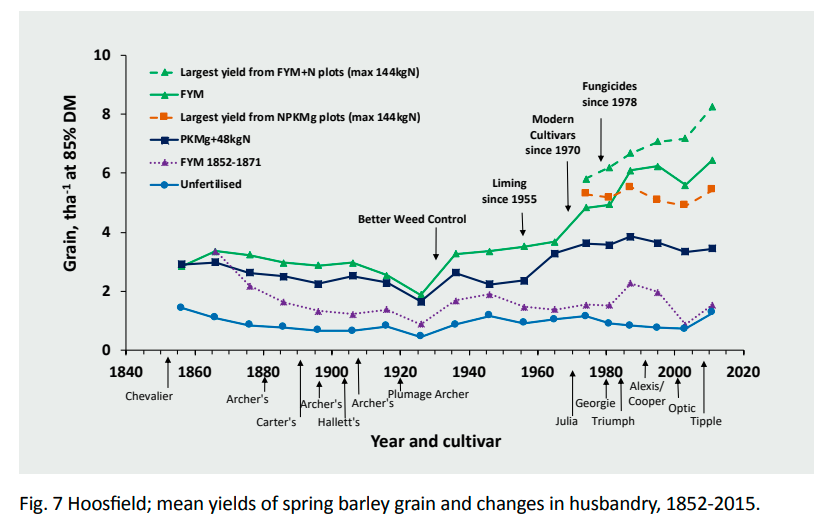
I have not found this data published (but it may be somewhere), but the almost deliberate deceit of Rothamsted reports often underplay the tangible result that, in about 180 years of cropping, the wheat and barley yields (and earthworms, SOC content, etc.) of the organic FYM plots consistently equal – or exceed – the chemical NPK plots. Seemingly, this applies to oats & corn crop yields too despite them being placed, again, at the bottom of the table!! And what of the mineral contents of these crops?? Yet how often is the story perpetuated that “organic yields are much lower than ‘conventional’ crops“.
Lies… All lies, just for $$s.
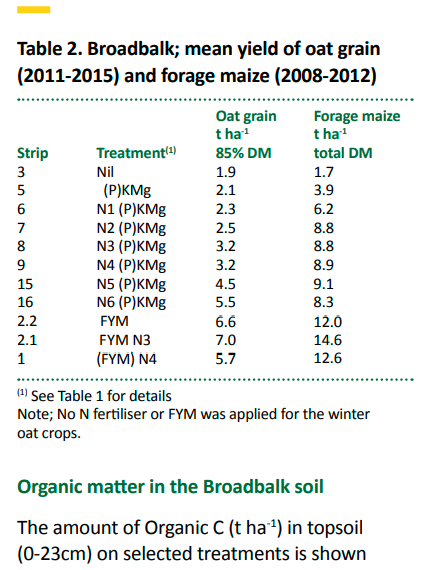
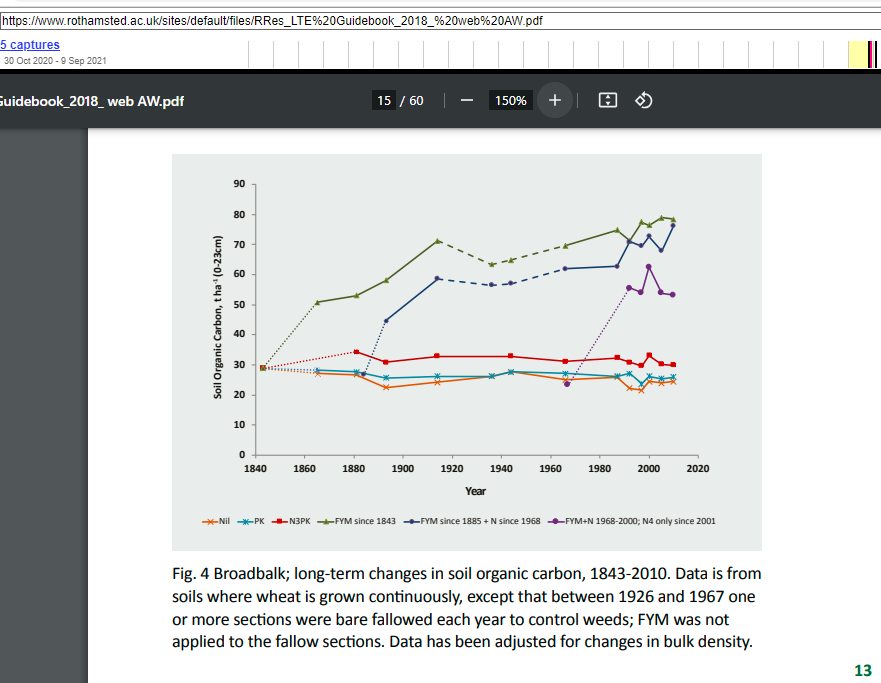
Table 2 of depressed oats and maize crop yields and Fig. 4 of soil organic carbon (SOC) loss, from 2018 Rothamsted Report (Ref.: page 12 – unsurprisingly this link does not work, here is Wayback version – https://web.archive.org/web/20201113062957/https://www.rothamsted.ac.uk/sites/default/files/RRes_LTE%20Guidebook_2018_%20web%20AW.pdf ). Do you see how NPK yields are about half FYM? Also how NPK has less than half the SOC of the FYM plots! Wow, so far they did a good job of keeping such data concealed from the farmers (and policy-making funders)!!
To clarify, after 180 years, Broadbalk yields of winter wheat in FYM and NPK are about the same (as shown in Figure 8 above) whereas oats & maize in NPK plots are about half 2.2 FYM plot of 6.6 & 12.0 t ha-1. Similarly, Hoosfield spring barley after 180 years in NPK plots of 3 tha-1 are half FYM plots of >6 tha-1.
Thus to reduce most of your crop potential (and to destroy the nutrient values, SOC & essential soil fauna) simply change from traditional organic FYM/compost to experimental chemical NPK regimes.
What’s the best way to Feed the World, Save our Soils and to restore lost biodiversity and human health? It’s a no-brainer…
But wait, it gets more surreal when massive externalized losses from bad agriculture ($12.7 trillion/yr) are added to the obscenely corrupt subsidies of $0.5-0.6 trillion/yr (Ref., and Ref.), e.g. – ‘In agriculture, direct subsidies of more than $635 billion a year are driving the excessive use of fertilizers that degrade soil and water and harm human health. Subsidies for products such as soybeans, palm oil, and beef cause farmers to push into the forest frontier and are responsible for 14 percent of forest loss every year‘. FAO (2023)* further state: “This report estimates that the global quantified hidden costs of agrifood systems were approximately 12.7 trillion 2020 PPP dollars in 2020. This includes environmental hidden costs from GHG and nitrogen emissions, water use, and land-use change; health hidden costs from losses in productivity due to unhealthy dietary patterns; and social hidden costs from poverty and productivity losses associated with undernourishment. Both unhealthy dietary patterns and undernourishment result in productivity losses affecting national economies; however, because the drivers differ significantly – undernourishment is driven by extreme deprivation, while unhealthy dietary patterns by overconsumption – hidden costs from unhealthy dietary patterns are linked to the health dimension, while those from undernourishment are related to the social dimension alongside poverty.” Most subsidies are for and costs are from failed agriculture promoted by chemists whereas organic farming has minimal help. These subsidies go to pay chemical companies.
“People say that there isn’t money for climate but there is – it’s just in the wrong places.” said Axel van Trotsenburg, Senior Managing Director of the World Bank. “If we could repurpose the trillions of dollars being spent on wasteful subsidies and put these to better, greener uses, we could together address many of the planet’s most pressing challenges.” “
*Ref. – FAO. 2023. The State of Food and Agriculture 2023 – Revealing the true cost of food to transform agrifood systems. Rome. https://doi.org/10.4060/cc7724en.
How much does agriculture produce in a year? FAO estimates the gross value of global (primary) agricultural production at just over $5 trillion. The World Bank estimates (primary) agricultural value-added at about $3.2 trillion. The contribution of the food industry and food services sectors is difficult to estimate because of lack of reliable data , but we estimate that the food system generates 2 to 5 times as much value as farm production itself (Ref.). Anyways. it seems big ag subsidies and externalized disbenefit costs are much higher, more than double, these basic farm produce values producing unwholesome food.
This quote is from Rockstrom et al. (2020): “Human and natural capital. A recent assessment puts the ‘hidden costs’ of global food and land-use systems at $12 trillion, compared to a market value of the global food system at $10 trillion. If current trends continue, these hidden costs could rise to more than $13 trillion a year by 2030. Today, food is an exceptionally subsidized and socially sensitive commodity. Not only is the planet subsidizing the global food system at a level that probably exceeds its global market value, the food system is also receiving massive direct subsidies from governments around the world. The European Union’s Common Agricultural Policy (CAP) is perhaps most prominent, currently accounting for 37.8% of the total EU budget. Shifting these types of subsidies to reward the production of public goods(such as carbon capture, habitat creation and improved water quality) presents a ready option for securing the global commons while supporting farming communities.”


2 thoughts on “Critical Decline of Minerals & Nutrients in Agrichemical vs. 100% Organic Foods”